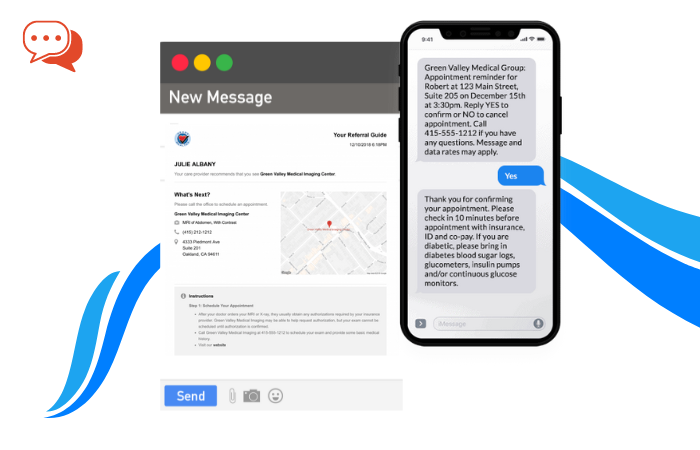During this time of pandemic-required social distancing, telemedicine has become a standard operating procedure for most medical practices – but practices are still looking for ways to generate additional revenue with the technology. This article will look at seven ways to generate revenue with telemedicine in your healthcare practice.
Initially, many healthcare providers approached using telecommunications technologies to communicate with their patients with skepticism. Still, as the COVID-19 virus continues to ravage U.S. viral hotspots, telehealth technology has allowed medical providers to triage and treat patients remotely without the additional risk of exposure to the disease.
There is a secondary benefit to telemedicine that providers should recognize. Now that most of us have mastered video conferencing as a way to provide care, it’s time to look at how telemedicine can become a revenue generator for your practice.
How Can Telemedicine Generate Revenue in Your Medical Practice?
Several barriers to telemedicine reimbursement lifted this year. CMS required parity in payment in April, among several other changes that incentivized providers to offer virtual visits. Patients can now receive virtual care in their homes, and healthcare providers can offer a telehealth visit from any location.
The fact that healthcare providers will receive reimbursement at the same rate as an in-person visit is significant from a revenue generation perspective. Telemedicine visits take on average less time than the traditional in-person visit. While we know telemedicine isn’t suitable for all visits, the virtual house call is now the standard of care for many types of routine encounters.
1. Telemedicine Attracts More Customers to Your Practice
From a marketing perspective, telemedicine is a great competitive equalizer. The virtual visit gives even the smallest practice a way to compete against market share encroachment from hospital ERs and urgent care providers. Offering on-demand telehealth appointments keep the medical practice current with the convenient service offerings found in large hospital systems, networks of minute clinics found in many retail settings, and in stand-alone urgent care.
For small healthcare providers, fitting in urgent, same-day appointments on top of a busy schedule is challenging. That creates an opportunity for niche providers and healthcare systems with more resources to swoop in and steal your customer revenue.
There are more than 160 million urgent care and ER visits in the U.S. each year, and one study showed 31% of Americans use these providers because they are faster and more convenient than a traditional office visit. But a medical practice can recoup this revenue with a telemedicine service line.
It is a convenience of telemedicine that will attract more patients to your practice. The virtual visit eliminates traveling to your practice for routine care. It’s a value-add for any medical practice seeking additional ways to attract customers and increase revenues.
2. Telemedicine Reduces No-Show Rates in the Medical Practice
Patient no-shows are still a thorn in the side of most American healthcare providers, who lose around $150 billion each year due to this phenomenon. One unused appointment slot can cost practice of $200 on average. Multiply that with the average no-show rate of around 5 to 7% to understand the financial burden of a no-show patient on medical practice.
Telemedicine can be used to reduce no-shows by bringing doctors and patients together virtually without the barriers that make it more likely for the no-show to occur. For example, patients are more likely to skip an appointment if they have to take off work, find childcare, or travel to a distant doctor’s office. If the patient doesn’t have vacation or sick time, the time spent traveling and waiting to see the doctor costs them income.
Orthopedic patients are frequent no-shows for routine post-surgical check-ups because their reduced mobility or pain makes them less likely to travel to a distant office. They may not be able to drive or use public transit, so they need transportation assistance. If that isn’t available, they’ll be at risk of a missed appointment.
A telemedicine visit reduces no-shows by bringing the doctor to a device as familiar as a cell phone. Patients can and should be seen in their homes virtually, cutting the costs and time associated with seeking a traditional office visit. A recent study showed telemedicine reduced no-show rates by 50%.
Every missed appointment means a direct hit on the bottom line plus an opportunity cost for the provider. Not only will you lose the patient encounter revenue, but there’s also the cost of underutilized staff. Telemedicine reduces no-shows and allows you to see patients more quickly. If you do have a no-show, it’s easy to fill the appointment with a telemedicine visit to recoup revenue.

Photo by Bermix Studio on Unsplash
3. Telemedicine Cuts Healthcare Costs
Telemedicine is simply a more efficient way to provide care. Virtual technologies eliminate overhead costs in the practice while lowering the average time spent per patient encounter. According to one study, practices save $24 per patient in overhead costs for every telehealth visit. It also illustrated that the savings cross over to patients, who save an average of $50 in travel costs per visit.
According to the Journal of Managed Care study, the average encounter time per patient, including their travel time, is 120 minutes. Yet, a telemedicine visit averages 16 minutes and can be completed from the comfort of the patient’s home. There is an obvious saving for patients and providers.
When you consider that the latest CMS rules require parity for telemedicine reimbursement at the same rate as an in-person encounter. When you couple this reimbursement rate with the cost savings earned from even one telehealth visit, the ROI is clear.
4. Telemedicine Retains Existing Customers
The secret to growing any business is, first, retaining existing customers. But healthcare, like all fields, is increasingly competitive. Independent practices compete with hospital networks, urgent care and minute clinics, ERs, and even on-demand telemedicine providers for the same patients.
But offering a telehealth service line can help you build patient engagement by providing more convenient care. Patients are increasingly frustrated by long wait times or by anything less than “on-demand.” Offering the option of a telemedicine visit when the doctor provides care to patients in their homes is an attractive proposition to many of our busy customers. Secure texting, emailing, and video chatting are all venues today’s patients are very comfortable with—even before COVID-19 changed how we do business. Promoting a virtual service line in your practice offers your patients a more convenient way for your patients to receive care. Telemedicine is patient-centric and, in this way, will continue to engage your patients that are frustrated with the traditional healthcare visit.
It should be noted that telemedicine also solves a big problem, which is that 3.6 million Americans do not obtain healthcare treatment because they don’t have transportation to get to their doctor’s office. It’s a big problem for older adults. But 96% of our patients own cellphones.
Telemedicine offers the convenience of bringing the doctor to the patient, not the other way around. This technology also solves barriers to accessing care. Offering telemedicine ensures that your practice will stay competitive by engaging your existing customer base.
5. Telemedicine Helps You See More Patients
Practices can leverage the flexibility of telemedicine visits to see more patients. For example, during the COVID-19 crisis, some providers used their asymptomatic but quarantined clinicians to recoup revenue by offering telemedicine visits from their homes.
Practices can fill no-show appointments but also use virtual visits to see more patients during a workday. This tactic increases practice revenues in obvious ways. If there are open schedule spots, you can fill them with a virtual visit. Practices can extend their hours and compete directly with ERs and urgent care.
For specialty practices that have limited their elective surgeries during COVID-19, telemedicine offers a way to recoup lost revenues. Too, specialists often have downtime between surgeries. They can remain billable with telemedicine by providing callbacks or scheduling post-surgical check-ups during what is normally wasted non-revenue producing times.
Ultimately, telemedicine is a tool of convenience. From the clinician’s perspective, the benefit is that you can see more patients in less time and with greater efficiency and less cost than the traditional visit. However, it should be noted that clinical teams can also use these tools to improve the quality of their lives by working from home with a videoconference. This saves travel time and provides busy clinicians with more work/life balance.
6. Telemedicine Increases Access to Your Practice
We know that our patients choose the convenience of urgent care and retail clinics over the traditional office encounter. In addition to encountering longer wait times in our offices today, the looming provider shortage virtually guarantees that there will not be enough clinicians to provide care to patients in the future.
A Merritt Hawkins study found patients in five medical specialties (cardiology, dermatology, family medicine, obstetrics-gynecology, and orthopedic surgery) in 15 major cities wait an average of 24.1 days even to get a new patient appointment. Wait times are increasing, and this puts more pressure on the entire system of care.
Telemedicine offers our struggling healthcare system a way to do more with less time. There is certainly a positive revenue impact that comes with a patient volume increase. The math is simple: The more patients you see, the more revenue accrued. But few healthcare providers would suggest that their work is strictly revenue-based.
Today, healthcare providers have a mandate beyond increased revenues to make their practices as efficient as possible. The predictors indicate by 2025. Patients will have a problem accessing care; wait times will be longer as more physicians retire in the coming years.
Telemedicine allows increased access for patients by stretching our clinical resources farther. It’s an intelligent solution for solving a big healthcare dilemma: Fewer doctors and nurses to treat the growing demand. Telemedicine can increase access to treatment while also increasing revenues in the medical practice.

Photo by Glenn Carstens-Peters on Unsplash
7. Telemedicine Cuts Patient Encounter Time for Some Types of Care
Telemedicine is an effective way to triage patients during COVID-19. Instead of bringing symptomatic but non-urgent patients to an office, potentially exposing staff and patients, triage can occur by phone or video conference; you can triage the patient by phone or video conference. Telehealth has long been used to treat contagious diseases, from pink eye to the winter flu.
For the specialist, telemedicine can be leveraged for routine post-operative care. 52% of patients report they would be open to having post-surgical check-ins as a virtual visit. Many surgeries are relatively minor, making them good candidates for a faster and more efficient telemedicine visit. This means doctors can knock these visits out quickly and schedule more of them throughout the day. The revenue generation potential is clear, and no clinical quality is sacrificed as a result.
For example, most orthopedic post-op checks are to look at the surgical incision to be sure it’s healing well. A doctor can view redness, swelling, or drainage through a video screen and even check mobility in a telemedicine post-op review. This opens up new potential for busy surgical specialists searching for ways to improve their time and efficiency.
Telemedicine Improves Practice Revenues
Telemedicine can be a significant revenue generator in any medical practice:
- Telemedicine visits are reimbursed at the same rate as the in-office encounter.
- Telemedicine takes less time than an in-person visit.
- The technology reduces no-shows.
- Telehealth tools are useful for attracting and retaining patients.
- Telemedicine makes even the smallest practice more competitive.
- The virtual visit helps doctors do more with less, increasing access to care while allowing our clinical teams to work more efficiently.
- Finally, telemedicine can cut patient encounter time for some types of care.
While this discussion has centered on telemedicine as a revenue generator in the medical practice, it should be noted that the technology is not appropriate for clinical encounters. More than three decades of data support telemedicine as a conduit for more efficient, safe, and high-quality healthcare.
As clinicians and patients embrace these tools like the new normal, more medical practices will benefit from this technology to build revenue in their practice.











